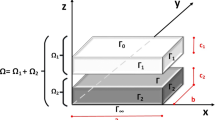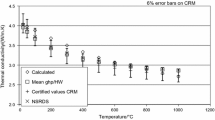Abstract
In the engineering applications, the thermal contact resistance has an important effect of heat transfer design and operation of systems and devices. For general contact heat transfer, as long as the geometry, mechanics and boundary conditions are known, the steady thermal contact resistance of the interface will be “unique,” which is independent of theoretical prediction and experimental measurement methods [1].
Access provided by Autonomous University of Puebla. Download conference paper PDF
Similar content being viewed by others
1 Introduction
In the engineering applications, the thermal contact resistance has an important effect of heat transfer design and operation of systems and devices. For general contact heat transfer, as long as the geometry, mechanics and boundary conditions are known, the steady thermal contact resistance of the interface will be “unique,” which is independent of theoretical prediction and experimental measurement methods [1]. In other words, for the same thermal contact resistance problem, the experimental value and calculation value should be completely consistent. The logical starting point of macrothermal contact resistance is single-point thermal contact resistance, which can be simplified as series connection of thermal constriction resistance, heat conduction and thermal spreading resistance [2]. Although there were many experimental methods for measuring thermal contact resistance, there are few experimental data on thermal spreading (or constriction) resistance [3]. Most of the models of thermal contact resistance have made a comprehensive analysis of the main physical mechanism, such as surface topography and deformation; however, the predicted results and experimental values are still quite different, and the predicted models and numerical methods are still difficult to be directly applied to engineering problems. Based on the single-point cylinder–cylinder contact model, this paper provides a standard method for verifying the accuracy of numerical simulation results and experimental apparatus.
2 Experimental Apparatus and Numerical Methodology
We have designed and set up an apparatus for measuring thermal contact resistance, which has four subsystems: heater and cooler, loading measurement, vacuum pump subsystem, data acquirement and process subsystem, which is shown in Fig. 1 [4]. The single-point contact specimens are stainless steel 304, and the radius ratios ε are 0.2, 0.3, 0.4, 0.5 and 0.6.
A single-point geometric and physical model of a cylinder–cylinder contact is established to study the thermal spreading (or constriction) resistance. The total thermal contact resistance R of the single point is the sum of thermal constriction resistance Rc, intermediate cylinder body conduct resistance Rd and thermal spreading resistance Rs that is
Because of the symmetry of the geometric model, the heat flow distribution of the upper and lower part is also symmetrical, which means the constriction resistance can be regarded as equal to the spreading resistance:
For the isoflux tube model, the dimensionless thermal spreading resistance can be calculated as follows [5]:
The calculation method of experimental values of thermal spreading resistance is as follows:
For the steady-state heat conduction of a simple cylinder–cylinder body, the 2D model and the 3D model are simulated at FLUNT platforms. We have verified the numerical solution methods and the grid independence.
3 Results
A comparison of theoretical, simulated and experimental values of dimensionless thermal spreading resistance under different area ratios is shown in Fig. 2. With the increase of area ratio, the dimensionless thermal spreading resistance decreases gradually, and the overall trend of experimental and simulation values is consistent. The simulation results and theoretical values have little difference in the same area ratio. The differences between simulation values and theoretical values show the characteristics of complexity under different area ratio ε. There are two major reasons for the deviation between the experimental and theoretical values of dimensionless thermal spreading resistance: (A) deviations between the experimental sample and the theoretical model and (B) measurement error.
4 Conclusions
-
(1)
The single-point contact thermal resistance method can be used to “calibrate” the precision of the test rig. Once the precision of measuring thermal contact resistance is determined, the effects of heat flux, temperature distribution, surface roughness, interface contact pressure, material properties and other factors can be studied quantitatively.
-
(2)
Experiments and numerical simulations show that the dimensionless thermal spreading resistances decrease ψ with the increase of the contact area ratio ε, which are consistent with the theoretical values.
-
(3)
The measurement values of thermal contact resistance are influenced by both macroscopic geometric model and experimental measurement error. Accurate calibration of thermocouples and reduction of heat leak can improve the precision of experimental measurement, but the deviation between numerical solution, experimental value and theoretical value cannot be completely eliminated. Air or other interface medium between the contact surfaces has a direct impact on the thermal contact resistance, and in some cases, there can be an order of magnitude difference.
References
A. Wang, J. Zhao, Review of prediction for thermal contact resistance. Sci. China Tch. Sci. 53, 1798–1808 (2010)
M. Razavi, Y. Muzychka, S. Kocabiyik, Review of advances in thermal spreading resistance problems. J. Thermophys. Heat Transfer 30, 863–879 (2016)
Y. Xian, P. Zhang, S. Zhai et al., Experimental characterization methods for thermal contact resistance: a review. Appl. Therm. Eng. 130, 1530–1548 (2018)
P. Fan, Experimental Research of Thermal Contact Resistance in Vacuum Environment (Master’s Degree Thesis in Chinese) (Beihang University, Beijing, 2013).
C. Madhusudana, Thermal Contact Conductance (Springer-Verlag, New York, 1996).
Acknowledgements
A. Wang thanks the grant of China Scholarship Council for this visiting at the UK. We also thank Mr. Fan Peisheng, Liu Liangtang and Gaotian for their hard work in building the test rig and measurement data.
Author information
Authors and Affiliations
Corresponding author
Editor information
Editors and Affiliations
Rights and permissions
Copyright information
© 2021 Springer Nature Singapore Pte Ltd.
About this paper
Cite this paper
Wang, A., Liu, Z., Wu, H., Lewis, A., Loulou, T. (2021). Numerical and Experimental Investigation on Single-Point Thermal Contact Resistance. In: Wen, C., Yan, Y. (eds) Advances in Heat Transfer and Thermal Engineering . Springer, Singapore. https://doi.org/10.1007/978-981-33-4765-6_75
Download citation
DOI: https://doi.org/10.1007/978-981-33-4765-6_75
Published:
Publisher Name: Springer, Singapore
Print ISBN: 978-981-33-4764-9
Online ISBN: 978-981-33-4765-6
eBook Packages: EngineeringEngineering (R0)






